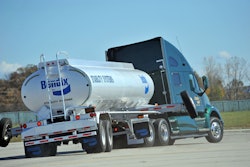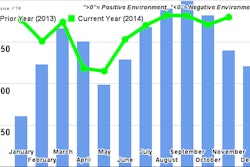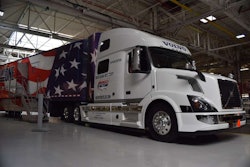The combination of video and big data, called video intelligence, has already transformed several industries. Commercial transportation could be next.
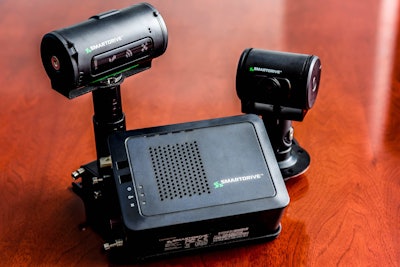 Video intelligence systems, like this one from SmartDrive, combine footage of risky events with a broad set of data on risky driving behaviors. CLICK on the image to view a gallery of the leading technologies.
Video intelligence systems, like this one from SmartDrive, combine footage of risky events with a broad set of data on risky driving behaviors. CLICK on the image to view a gallery of the leading technologies.Fleet owners in this high-risk, low-margin industry see the technology as a way to protect themselves and their drivers from the ever-present threat of litigation.
The University of Michigan Transportation Research Institute — a leader in truck-related crash research — studied 8,309 fatal car-truck crashes to determine fault. Car drivers were assigned fault 81 percent of the time versus 27 percent for truck drivers. Without video evidence, the odds are unlikely to be this favorable towards trucks in the courtroom.
Pitt Ohio began using video intelligence in 2012. The merits of the SafetyDirect system from Bendix were validated when one of its trucks was involved in an accident on the Pennsylvania Turnpike soon after.
An SUV crashed into a concrete barrier on the left side and then crossed into the right lane, striking the Pitt Ohio truck and taking out its steering axle. The truck crashed into a barrier on the right side. The passengers in the SUV were injured and looking for a scapegoat.
“They were coming after us,” says Jeff Mercadante, vice president of safety for Pitt Ohio. “Three people were trying to say we hit them.”
Pitt Ohio showed a video of the event to the insurance company representing the SUV owner. The case was settled quickly and Pitt Ohio received $34,000 in damages.
Video intelligence platforms are designed to capture a short clip of incidents before and after a trigger event such as speeding, swerving and sudden deceleration. They also capture data from such events and deliver an efficient way to manage risk with this three-step process:
1. Creating a risk profile
Besides offering liability protection, some platforms feed the content from the video and event data into advanced predictive models. These models calculate the risk profile for every driver in the fleet to identify where the fleet needs to focus its efforts.
The DriveCam program from Lytx, for example, shows driver managers a ranked list of drivers by priority for coaching and intervention. The company uses predictive analytics to determine which behaviors are the most at risk.
Lytx is currently working on an initiative to bring data into its driver risk profiles from outside sources, like CSA violations, to create an even more complete driver profile. Its predictive model shows that hours-of-service violations are a predictor of collisions, says Rob Bartels, senior vice president of trucking for Lytx.
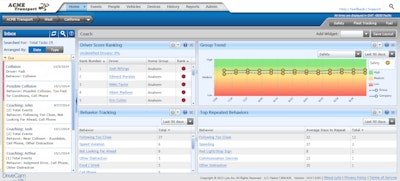 Web portals, like this one from DriveCam, show fleet managers what actions to take immediately to improve fleet safety. CLICK on the image to view a gallery of leading video intelligence systems
Web portals, like this one from DriveCam, show fleet managers what actions to take immediately to improve fleet safety. CLICK on the image to view a gallery of leading video intelligence systemsThe company is integrating information from RAIR, which provides compliance management services to fleets for hours of service and driver qualification files, into the DriveCam program. Lytx acquired RAIR in 2011.
Lytx has already created a singular reporting platform for DriveCam safety and RAIR compliance information. It is now working on integrating the coaching management tools of the two platforms, he says.
Transportation companies already have more data than they know what to do with, says Steve Mitgang, chief executive officer of SmartDrive. What they want is to know what to do right now to prevent the next accident.
“Yes, we have cameras, but we want to be the video and ECU data company that wants to use data to transform the efficiency of fleets. If you think of it that way, you actually do things really different,” he explains. “You have to be good at understanding a huge volume, variety and velocity of data. We understand it in real time and give you recommendations and optimizations.”
Insights gained from using SmartDrive go beyond safety to fuel, maintenance, workers compensation and worker compliance, he says.
SafetyDirect from Bendix wirelessly transmits real-time driver performance and event-based information – including video clips of severe occurrences – to the fleet’s back office for analysis by fleet safety personnel.
“We review every event,” says Pitt Ohio’s Mercadante. Pitt Ohio uses its own risk management system, called SafetyBox, to track driver safety and performance in a number of categories. The system sends safety supervisors an alert if two “minor” events occur in a 12-month period. The supervisors then interview the driver about what is causing the distraction.
“If we nip that and cut down the minors, we do not get a major event,” he says.
2. Turning data into action
Video has a unique ability to change driver behavior as it leaves no room for second guessing or excuses.
Cypress Truck Lines, a flatbed carrier based in Jacksonville, Fla., operates 500 power units in the eastern half of the United States. The company began outfitting its fleet with SmartDrive in September, 2014, following a six-month testing and evaluation period.
The company is putting cameras in all trucks with new drivers to “get a good look” at who they’ve hired, says Thad Penland, vice president of Cypress Truck Lines.
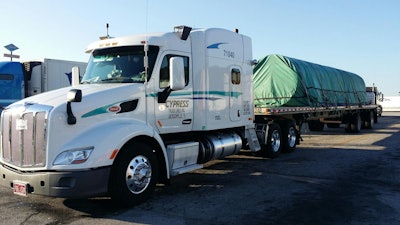 Cypress Truck Lines is putting cameras in all trucks with new drivers to “get a good look” at who they’ve hired. CLICK to view a gallery of leading video intelligence systems.
Cypress Truck Lines is putting cameras in all trucks with new drivers to “get a good look” at who they’ve hired. CLICK to view a gallery of leading video intelligence systems.Within weeks of implementation, the company has seen its SmartDrive safety scores improve by 57 percent with reductions in speeding and distracted driving by 58 percent and 48 percent respectively.
Pitt Ohio was one of the first fleets to use the SafetyDirect product from Bendix.
“It works,” Mercadante says. “You coach the driver and show him what he did wrong and he learns from it.”
Long Haul Trucking deployed the DC Protect program, part of the DriveCam powered by Lytx family of products, after several months of testing.
“Prior to the DriveCam program, you could sense when someone was a safe driver, but you couldn’t actually prove it like you can with a video-based system like DriveCam,” said Sue Brown, safety director for Long Haul Trucking. “Now we have tangible evidence and can coach, reward, and promote accordingly. Our compliance ratings have gone up as well, as incidents of seatbelt infractions disappeared almost immediately after the trial began.”
3. Expanding the view
Besides using forward-facing and driver-facing cameras, video intelligence platforms are able to expand visibility around the vehicle to detect risk.
This year, PeopleNet plans to offer a system that uses small cameras installed in various locations around the vehicle. The video will feed into a separate DVR on the vehicle, which will transmit video to an online portal for fleet managers to review along with critical event data.
The system will also connect to PeopleNet’s Mobile Gateway onboard computer to stream live video to PeopleNet’s in-cab driver displays. With this connection, drivers can see blind spots on the tractor’s left or right side when using the turn signal and behind the tractor or trailer when in reverse.
The company is also going to add a “go fetch” service that will allow fleets to view video of a certain event, such as a loading activity, within 72 hours after it happened. Its video intelligence platform will bring in driver data captured by its mobility platform for a comprehensive view, says Mike Nalepka, general manager of video intelligence solutions for PeopleNet.
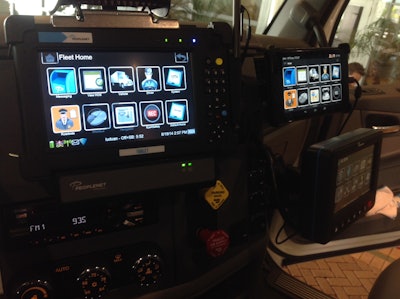 PeopleNet is developing an integrated video intelligence system that captures footage from around the vehicle. CLICK to view a gallery of this and other systems.
PeopleNet is developing an integrated video intelligence system that captures footage from around the vehicle. CLICK to view a gallery of this and other systems.SmartDrive has made its risk management system configurable with up to four cameras to obtain a 360-degree view. Its new SmartDrive Assurance product line can be fine-tuned to match the risk priorities and specific fleet operating environments of fleets, it says.
Kimrad Transport, and its sister company, Bulk Crude Transport, based in Amarillo, Texas, operate a combined fleet of 270 tractors that power a fleet of cargo tank trailers in west Texas and surrounding states.
The company plans to install rear-facing cameras behind the cab and on trailers that integrate with SmartDrive to capture additional incidents and unsafe practices on video. With this initiative, the company will be able to document and protect itself and its drivers during the loading and unloading process.
“There are lots of opportunities for drivers to get hurt and make mistakes,” says Brad Pohlmeier, the owner of Kimrad.
Video intelligence platforms not only capture video and event data; they use it to predict future events. With this technology, fleet managers are able to resolve issues quickly that may otherwise go undetected.
The Who’s Who of video intelligence
Lytx has more than 1,000 fleet customers worldwide that use its driver safety and compliance applications and services. It plans to grow between 35 and 40 percent in 2015.
SmartDrive has devices installed in class 8 tractors and many other types of vehicles. Much of its growth has come during the past two years. The company expects to double in size in 2015 and beyond.
Bendix SafetyDirect wirelessly transmits video and event data automatically through a fleet’s existing communications platform. Bendix has a number of vehicle and driver safety systems linked to SafetyDirect, which it says optimizes the benefits of all these technologies through its data collection and reporting capabilities.
PeopleNet is expanding its fleet mobility platform to include the capture of video around the tractor and trailer for liability protection and surveillance of events. The company is focusing specifically on reducing lane change incidents by removing blind spots for drivers.




